#maiolica ware
Photo
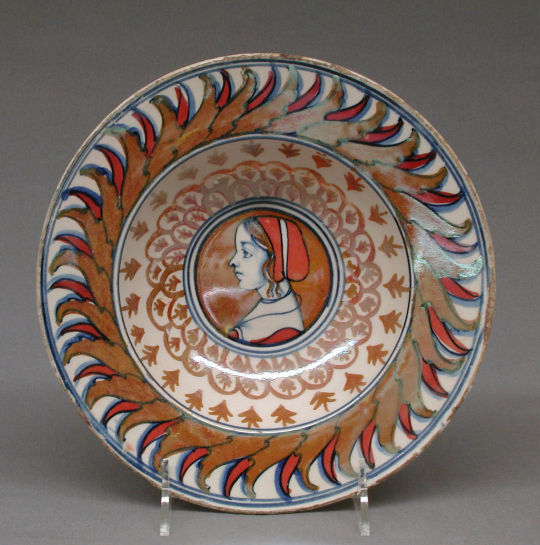
Dish with portrait of a girl ca. 1520
Italian, Gubbio
96 notes
·
View notes
Text
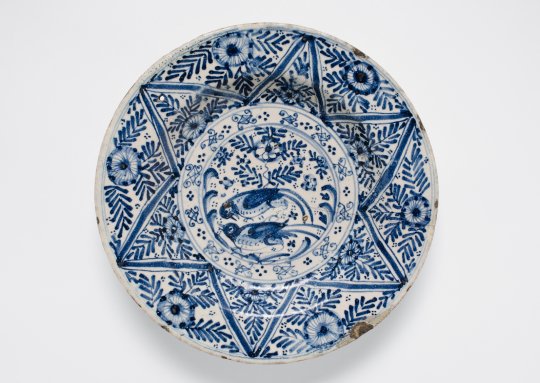
. Dish
Early 18th centuryArtist/maker unknown, Spanish
Maiolica is an Italian term used to describe a tin-glazed ceramic that reached the height of its popularity during the fifteenth and sixteenth centuries. Fairly inexpensive, maiolica wares were suitable for everyday use, frequently taking the form of pharmacy jars, vases, and dishes.
Maiolica was born of a desire to emulate porcelain, a delicate and translucent form of pottery that until the eighteenth century only the Chinese knew how to make. The technique was a complicated multi-step process. First, the clay was collected, strained, and dried to a plastic consistency. Then it was shaped into the desired wares, by wheel, mold, or hand and fired in a kiln. Once fired, the ceramic was covered with an opaque white glaze containing tin, an expensive metal imported into Italy from England or the Low Countries (present-day Netherlands, Belgium and Luxembourg). The porous ceramic absorbed this glaze immediately, leaving a powdery white coating on the surface. It was then painted using pigments made from ground metals suspended in water. The most common pigments were made from metallic oxides: copper made green, iron made orange, manganese made purple, cobalt made blue, antimony made yellow, and tin made white. Again the ceramic absorbed the water in the paint, leaving the pigments on the surface and making it nearly impossible to correct any errors or change the composition. When the painting was completed, some vessels were coated with a shiny lead glaze, and then all were fired again, at a slightly lower temperature.
3 notes
·
View notes
Photo

Dish with a Lion, c. 1430-1450, Cleveland Museum of Art: Medieval Art
This dish is representative of the rustic type of maiolica produced in Italy before 1450. The design is much inspired by contemporary Spanish earthenware. The surface of the dish is painted in a cobalt blue impasto technique known as zaffera a rilevo. Lions frequently adorn wares decorated in this technique and are particularly appropriate as a Florentine motif-they probably refer to that city's lion emblem.
Size: Diameter: 28.6 cm (11 1/4 in.)
Medium: tin-glazed earthenware (maiolica)
https://clevelandart.org/art/1966.19
165 notes
·
View notes
Photo
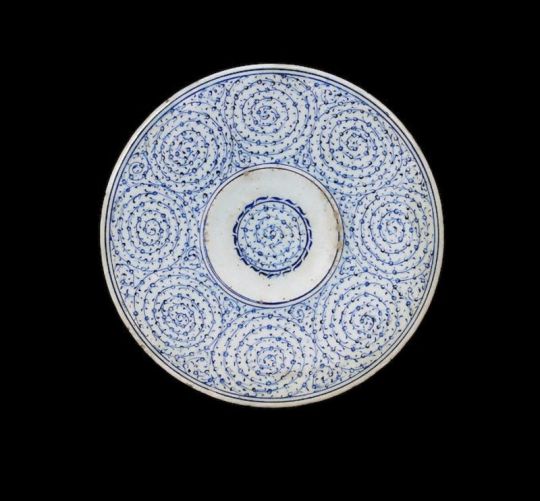


An Iznik "Golden Horn" pottery Tondino Turkey, circa 1535-45
Tondino dish with spiral patterning
Tondino dish, c. 1530–1540 https://en.wikipedia.org/wiki/Iznik_pottery
“ The so-called 'Golden Horn ware' was a variation on the blue and white decoration that was popular from the late 1520s to 1550s. Golden Horn ware was so named because sherds in this style were excavated in the Golden Horn area of Istanbul. It was later realized that the pottery was made in Iznik as some motifs on the vessels closely resembled those used on other blue and white Iznik pottery. The decoration consists of a series of thin spirals adorned with small leaves. The narrow rims of dishes are painted with a meandering pattern. The design is similar to the illuminated spiral scrolls used as a back ground to Sultan Suleyman's Tuğra, or imperial monogram. Julian Raby has used the term 'Tuğrakeş spiral ware' as the tuğrakeş were the specialist calligraphers in the Ottoman court. The earlier vessels were painted in cobalt blue while later vessels often include turquoise, olive-green and black. A number of dishes dating from this period show the influence of Italian pottery. The small bowls and a large flat rims are similar in shape to maiolica tondino dishes that were popular in Italy between 1500 and 1530. “ ( via )
40 notes
·
View notes
Text
Spinet, Thomas Gainsborough, Garton Orme, bordaloue, imari ware, maiolica... i learned of these today in Bath, tho my dumb brain just thinks 'want another flat white' which is why becoming a foodie is bad, kids. Plus it will make you corpulent. I try to live off coffee and nicotine like the Sheryl Crow song (this is my sense of humour, to abase myself with middling art, or general self-abasement in a emotional albeit lazy way) minus the nicotine.
Maybe i'd be better if i stopped telling the world 'i'm a very bad boy, daddy, really just a piece of shit my politics are shit my face is shit my coat is shit my everything is shit and fucked up gee daddy (daddy hates denim with a sherpa collar)' but at least that why you never Are that horrible daddyman, right kids?
Brits value humility but Americans value confidence
Duh on which mode of life is superior and sexier... the men over here in the UK are far more attractive
I forget where im going with this other than it is a long hard road to having your life being where you want it to be, and if you're not careful you'll just turn into a monster in the process or wind up dead. All those noses with the tips cut off by plastic surgeons... all those Fat Bastard rich dudes... and you better believe they hate your natural nose too.
Ah, the point is that i want my life in a different dimension or higher plane -- and i am so loathe to use the word higher because it's a sky cultist world -- but that just entails a lot of ardour and perhaps outright tortue that might suck from you your very lifeblood or soul or best times.
That is the dilemma
1 note
·
View note
Photo

Italian Maiolica: Ceramics of the Renaissance
“The evolution of the term Maiolica is almost as interesting as the development and spread of the style itself.
There are four different meanings associated with the term.
- In origin the word is a medieval Italian form of the name of the island of Majorca.
- Renaissance Italians used the term to describe Hispano-Moresque imports and other luster wares, which were sometimes shipped through Majorca to Italy.
- In modern Italian (and some parts of Italy in the 16th century) its meaning has broadened to ‘tin glazed earthenware’.
- In English, it is used to refer to tin glazed earthenware in the stylistic tradition of the Italian Renaissance. “
“The first examples of this technique were found in Baghdad and dated to the 9th Century - there symmetrical patterns were painted in blue and white.However by the by the end of the 11th century Islamic pottery, including lusterware, had been in widespread use for the embellishment of religious and civic buildings.Thought to have been introduced by the crusaders at the as trophies demonstrating victories over the pagans by powerful Christian forces.During the 13th through to the early 15th century Tuscany had good trade relations with Moorish Spain and imported large quantities of lusterware from Spain. This is when the Italians began to work with tin glazed ware.It is interesting to note that the only difference between the Italian and Spanish products of this period is the absence of luster on the Italian wares.The map shows the sweeping migration of tin glazed tradition from Baghdad, then with the advance of Islam, it was carries the length of the Northern African seaboard into Moorish Spain, this occurred during the 10th Century. Then during the 13th Century through to the 15th Century, Spanish pottery was transported through Majorca to Italy.The Italians took great pains to copy the styles of the Spanish and Islamic designs but remained ignorant to the production of luster tones which were found on these tin glazed ceramics.In place of the luster, the Italians imitated the effect by using orange-yellow color through fine manganese. Italian Maiolica eventually dominated the pottery of Europe and set a trend that lasted more than three hundred years.“
https://www.artistica.com/pages/italian-maiolica-ceramics-of-the-renaissance
1 note
·
View note
Photo
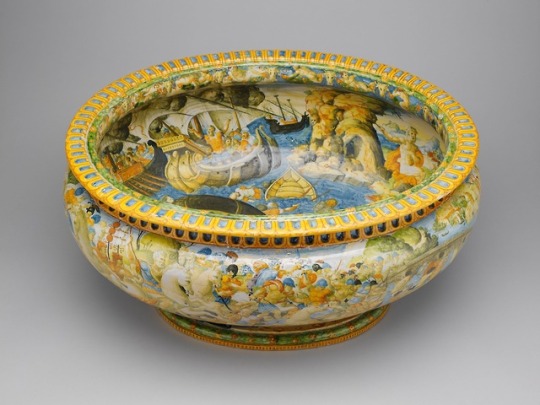
Wine Cistern, Francesco Durantino, Italy, 1553
Art Institute Chicago
Provenance: Possibly acquired by Sir Andrew Fountaine (1676-1753) in Italy in the early eighteenth century and passed to his heirs by descent [Scheidemantel, 1968, p. 52]. Andrew Fontaine (d. 1873), Narford Hall, Norfolk; by descent to heirs [according to C. Drury Fortnum, Maiolica (Oxford,1896), p. 77]; sold, London, Christie’s, 1884, no. 389, to Galerie Stettiner, Paris, for £336 {according to annotated copy of sales catalogue in the British Museum, referenced by Scheidemantel, 1968, p. 58]. Baron Eugen Miller von Aichholz (b. 1835 - d. 1919), Palast Aichholz, Vienna, before 1900 (his sale, Paris, Galerie Georges Petit, May 18-22, 1900, no. 101). Fernand Adda (d. 1964), Alexandria and later Paris and Rome; his sale, Paris, Palais Galliera, November 29-December 3, 1965, no. 601; sold to Edward R. Lubin Gallery, New York [according to letter in curatorial file]; sold to the Art Institute, 1966 [according to receipt in Registrar’s files]
53.3 × 26.7 cm (21 × 10 1/2 in.)
1966.395
Maiolica, also called Majolica, is Italian tin-glazed pottery dating from the Renaissance period. It is decorated in colours on a white background, sometimes depicting historical and mythical scenes, these works known as istoriato wares ("painted with stories"). By the late 15th century, several places, mainly small cities in northern and central Italy, were producing sophisticated pieces for a luxury market in Italy and beyond.
[text source: @wikipedia]
Francesco Durantino,��perhaps the most prolific istoriato maiolica painter of the mid-sixteenth century, stands out relatively clearly from the anonymous crowd of Urbino-school maiolica craftsmen. His work can be identified with some confidence on the basis of a group of signed works, and thanks to recent archival discoveries something is also known of his career, which began circa 1542.
[text source: @nationalgalleryofart]
#maiolica#art#francesco durantino#italy#renaissance#public domain#museum#art history#16th century#wine
14 notes
·
View notes
Photo

Art of the Day: Bowl with Apollo and Daphne
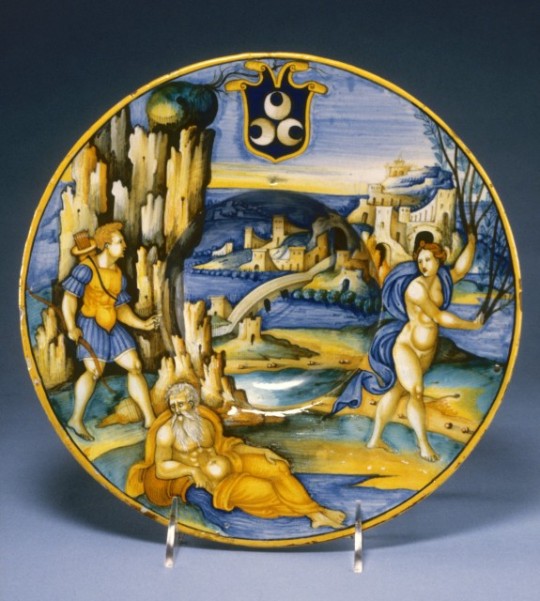
This bowl depicts a scene from the Roman poet Ovid’s (43 BCE—17AD) “Metamorphoses” (Book I), in which the nymph Daphne is pursued by Apollo and saved from his advances at the last moment by her father, the river-god Peneus, who turned her into a laurel tree. Peneus reclines in the foreground, while Apollo is shown on the left, and Daphne’s transformation occurs on the right. The figures of Apollo and Daphne may be derived from a woodcut in a 1497 Venetian edition of Ovid's text. This scene is characteristic of “istoriato” wares, which portrayed stories from Classical antiquity and the Bible, and emerged in Italy during the early sixteenth century. The back of the bowl is stained with green and ornamented with two concentric yellow circles, with two raised circles at the rim.
The coat of arms on this bowl associates it with the “Three Crescents Service,” a large group of wares possibly made for a member of the Strozzi family in Florence. The bowl was produced by the “Milan Marsyas Painter,” who is thought to have produced a group of wares depicting the mythological flute-player Marsyas, now in the Castello Sforzesco in Milan. To see more works by the Milan Marsyas Painter, click on the name in the creator field; for information on ‘maiolica’, see 48.1336. Learn more about this object in our art site: http://bit.ly/2X22pMp
13 notes
·
View notes
Text
A Natural Treasure
Made of faience, a type of tin-glazed earthenware produced in France, this brightly colored inkstand held a pot for ink, a sander, pens, and various writing accouterments. Initially derived from Middle Eastern regions before the 9th century, faience developed in France during the 16th century; the French producers were largely influenced by Italian makers of maiolica, another type of tin-glazed earthenware dating from the Renaissance. Tin-glazed and enameled French faience was used to produce decorative objects for everyday use, such as plates, platters, mugs, tureens, vases, and more.[1]
The production starts with a mixture of clay that is then formed, and coated with glaze and metallic oxides before being fired a single time in a kiln at temperatures exceeding 1,830 °F (1,000 °C). This French technique was called Grand Feu (high fire). In a second technique, the Petit Feu (little fire), the clay is fired before and after application of the glaze and metallic oxides. The second firing is done at a lower temperature; this technique allowed for greater precision in painting and a broader range of colors.
There were three major faience manufacturers in France: Nevers, Rouen and Moustiers[2] This inkstand was made in Moustiers Sainte-Marie, the ‘ceramic capital’ of a small village located in the southeastern Alpine region of France. Moustiers ceramics were highly favored by the 18th-century aristocracy, particularly after Louis XIV had his silver objects melted down as a way to pay his war debt. Colorful faience dining ware restored a sense of luxury to the royal table. The porcelain-like appearance appealed to the nobility, and the wares’ colorful charm appealed to all social classes. Made mainly from natural and locally accessible materials, faience production flourished.
Early Moustiers faience sported a monochromatic palette: delicate blue decoration on a white surface that most often depicted figures and interlaced grotesques. This inkstand represents the emergence of a polychrome palette, as well as the appearance of whimsical figures surrounded by vegetation placed randomly about the ceramic surface. Made possible by the Grand Feu technique, hues such as mustard yellow and olive green enlivened the color repertoire.
This object is on view in Moustiers Ceramics: Gifts from the Eugene V. and Clare E. Thaw Collection at Cooper Hewitt.
Molly Beegoo is a Curatorial Fellow in the Product Design and Decorative Arts department at Cooper Hewitt, Smithsonian Design Museum, and a first-year graduate student in the History of Design and Curatorial Studies program offered jointly by Cooper Hewitt and Parsons School of Design.
[1] Barber, Edwin Atlee. Tin Enameled Pottery: Maiolica, Delft, and Other Stanniferous Faience. Miami FL: HardPress Publishing, 2013.
[2] Waselkov, Gregory A., and John A. Walthall. “Faience Styles in French Colonial North America: A Revised Classification.” Historical Archaeology 36, no. 1 (2002): 62-78. doi:10.1007/bf03374339.
from Cooper Hewitt, Smithsonian Design Museum https://ift.tt/2Q3OwhY
via IFTTT
7 notes
·
View notes
Photo

Pharmacy jar (albarello) dated 1573
Probably workshop of Giacomo Mancini, "El Frate"
89 notes
·
View notes
Photo
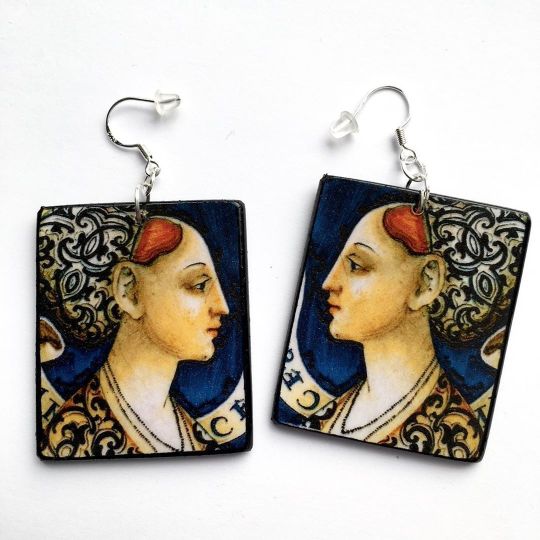
Wooden earrings Italian Renaissance majolica art. “The years between 1470 and 1530 witness the most spectacular period of development in the history of Italian maiolica (tin-glazed earthenware). Potters produced wares of artistic sophistication and variety never seen before” #majolica #ceramics #italianrenaissance #art #kunst #earringsaddict #alternativeweddings #etsy #etsyearrings #portrait #obljewellery #obljewelleryetsy #artbasedjewellery #uniqueart #faenza #maioliche #etsysuccess https://www.instagram.com/p/CBGSZhwIWuN/?igshid=15tieexgnqhtl
#majolica#ceramics#italianrenaissance#art#kunst#earringsaddict#alternativeweddings#etsy#etsyearrings#portrait#obljewellery#obljewelleryetsy#artbasedjewellery#uniqueart#faenza#maioliche#etsysuccess
0 notes
Photo

Albarello with Two Rabbits, 1300s, Cleveland Museum of Art: Medieval Art
This albarello, a cylindrical jar used to store dry medicinal herbs, exemplifies the wares of Paterna, near Valencia. Its decoration is dominated by the crest of the Luna family, Lords of Paterna, under which two rabbits are shown nibbling on a grapevine. These vessels were commonly used in spice stores and hospital pharmacies.
Size: Overall: 22.3 x 9.9 cm (8 3/4 x 3 7/8 in.)
Medium: tin-glazed earthenware (maiolica)
https://clevelandart.org/art/1943.276
22 notes
·
View notes
Photo


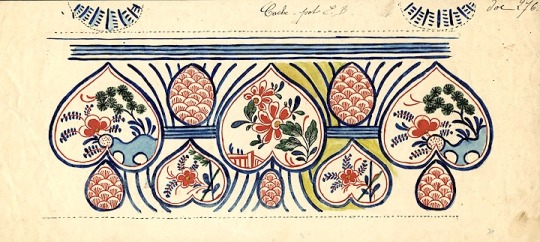

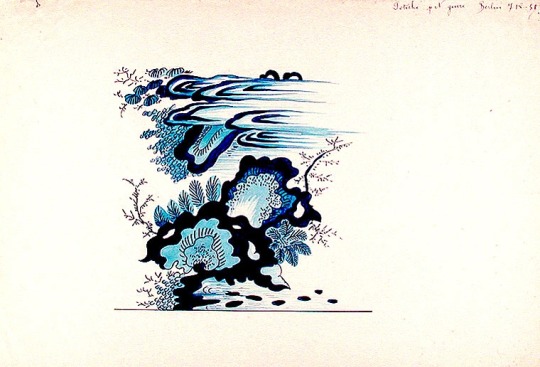
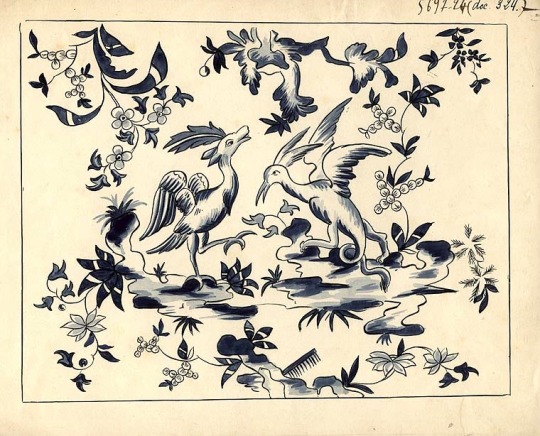

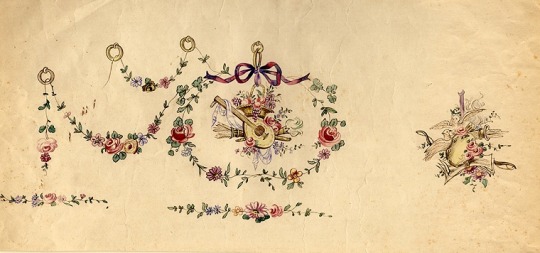
Faience Watercolours
SAMSON & CO. (designers)
Original designs for porcelain.
The French porcelain manufactory of Samson & Cie. was established by "Edmé Samson (b. Paris, 1810; d. Paris, 1891) at 7, Rue Vendôme (later Rue Béranger) in Paris. The intention of the firm was to reproduce ceramics from museums and private collections, and it claimed that all such reproductions would be distinctly marked to avoid confusion with the originals. In 1864, the factory was moved to Montreuil by Samson's son, Emile Samson (1837-1913). The range of wares included copies of 18th-century porcelain from such factories as Sèvres, Chelsea, Meissen and Derby, Chinese export-wares, especially armorial wares decorated with famille rose colours and mugs decorated with the Fitzhugh pattern, Delftware, Iznikware, maiolica and faience.
48 notes
·
View notes
Text
The Potter's Dictionary of Materials and Techniques By Frank Hamer, Janet Hamer
05/01/19
Delft
French = Faience, Spanish = Maiolica, tin-enamelled ware, tin-glazed earthenware
mid 16th century Italian potters in Delft began the production of the ware
Is likely that these Italian potters emigrated to England - can’t be proven before 1630.
English Delft: “never reached the perfection of the Dutch in thinness of potting and quality of glaze”
- did not imitate Oriental and Continental wares
- gained freedom of overall decoration - artistic expression
- in England, delft made in Lambeth, Bristol and Liverpool
- was produced in Britain until development of creamware early 18th century
**note to self - mentions that the quality of glaze is often lower in English delft - the vase I am exploring could be English as there is smudging of the blue caused by glazing
- Less interested in imitating Chinese designs - need to look at if the motifs on my vase are typical Chinese or are they Western motifs
Hamer, F. and Hamer, J. (2016). The Potter's Dictionary. London: Bloomsbury Publishing Plc.
0 notes
Photo
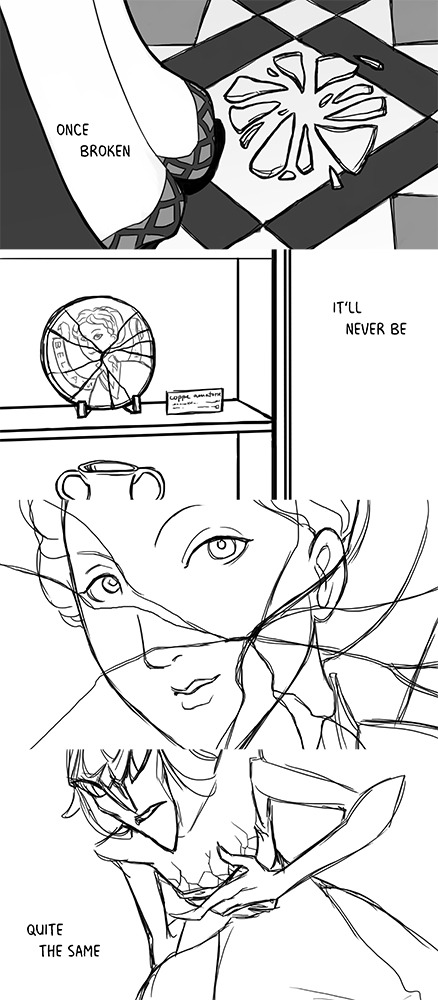
I LIED! Ok as i’m extremly unsatisfied with anything i’m doing today and this thing will make sence only to the renaissance pottery side of tumblr, i’ll make it quick.
In 16th century Italy there was a thing called coppe amatorie (love cups or plates) maiolica ware that were given as a betrothal gift. They were frequently decorated with idealised image of the future bride (Bella Donna) and also have some inscriptions, paizing her beauty or the virtues.
My symbolism is as subtle as my flirt
393 notes
·
View notes
Photo



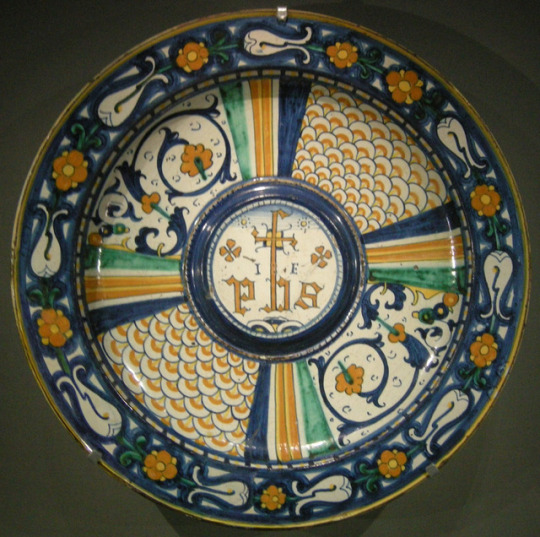
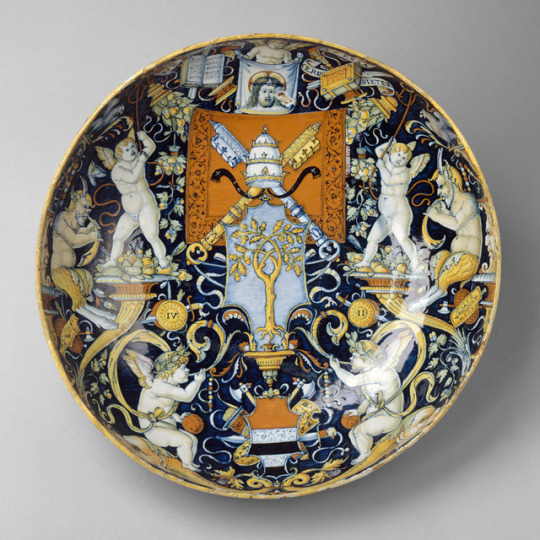

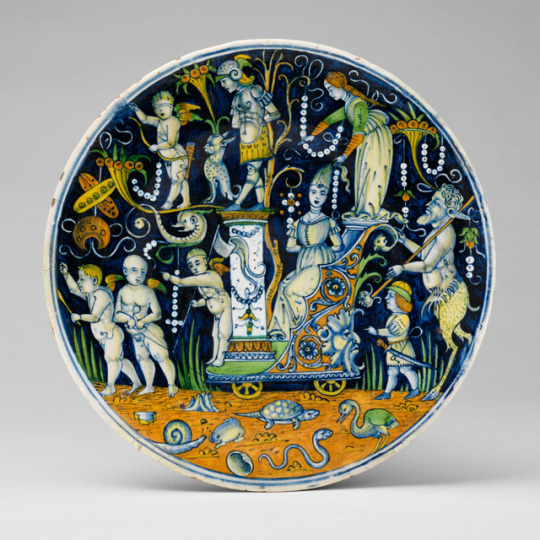


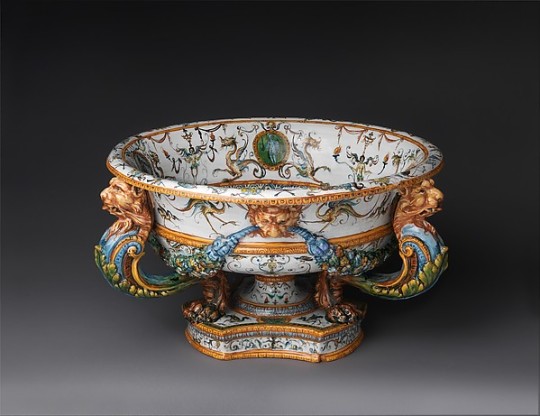
MARGINALIZED MEDIA I: RENAISSANCE MAJOLICA
This series explores artistic media whose status in the history of art and its importance within its contemporary culture have not always been in agreement.
Majolica was the Italian word for painted, white, tin-glazed ceramics of Islamic origin , which were produced in Spain and imported through Majorca. The name was also applied to the indigenous tin-glazed earthenware and lustreware produced primarily in the Florentine contada in the 15th century, and in the 16th century in Deruta and Gubbio in Umbria, Faenza in the Romagna, and Castel Durante, Urbino and Pesaro in the Marche.
The tin-glazing technique creates an opaque white enamel, which is well-suited for the application of hand-painted decoration. Painted wares were then refired with a translucent slip to protect the decoration. In the 15th century, advances in pigment chemistry expanded the palette of colors available to ceramicists. These technical developments allowed majolica painters to pursue the sophisticated pictorial and decorative effects seen in panel, manuscript and fresco painting.
The ambitious and aesthetically-adventurous producers of Renaissance majolica transformed a centuries-old, humble craft tradition into an advanced mode of artistic medium expression patronized by the most discerning patriciate and nobility in Italy and abroad within a decade or two.
Majolica is still the principal manufacture of Deruta.
Faïence and Delftware are derivatives of Italian majolica.
The Victoria & Albert Museum and the Metropolitan Museum of Art both have large majolica collections of the highest quality.
After decades of neglect, majolica and its major practitioners have been re-admitted to the canon of Renaissance art. In 2016, the Metropolitan Museum of Art published Timothy Wilson and Luke Syson’s Maiolica: Italian Renaissance Ceramics in the Metropolitan Museum of Art and mounted the exhibition Renaissance Maiolica: Painted Pottery for Shelf and Trade.
#maiolica#tin-glazed pottery#islamic ceramics#renaissance art#deruta#faenza#faïence#albarello#scodello#majorca
4 notes
·
View notes